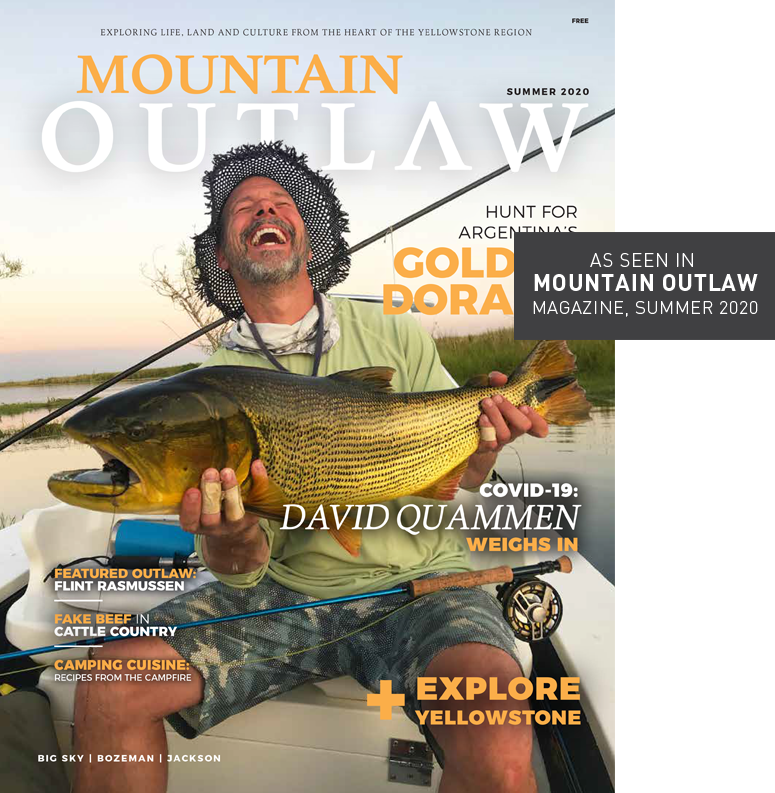Should we have been prepared for the novel coronavirus?
BY TODD WILKINSON
For a science writer who has spent much of his career exploring the innerworkings of the natural world—and understanding the origins of ecological disasters—David Quammen derives no solace from having his warnings proved right. Be it witnessing the loss of species as part of the sixth major extinction episode, which may now be underway, or being deadly accurate in predicting a disease event like this year’s COVID-19 epidemic, Quammen makes no claim to wielding clairvoyant power.
Nor, for that matter, is he interested in writing Chicken Little “the sky is falling” jeremiads. The simple explanation, relating to what informs his critically acclaimed work, is that he listens to what the best scientists on the planet have to say—many of whom have told him directly—and then translates it so the public can understand.
Growing up in Cincinnati, Quammen, 72, came to Greater Yellowstone as a young man after graduating from Yale and then as a Rhodes Scholar at Oxford, not with a penchant for science writing but as an aspiring young novelist who paid the rent by working as a Madison River fishing guide and bartender in Ennis. Eventually, Outside magazine enlisted him to write a regular column, “Natural Acts,” and both his interest and esteem took off from there. Now writing regularly for National Geographic, he’s counted among the finest nature writers of our time.
When it comes to ground-truthing, he’s been no desk jockey. Conducting field research for his book The Song of the Dodo, Quammen visited with residents of the jungle where not long before a number of people had mysteriously from eating primates as bush meat. It turns out the animals were infected with Ebola. He’s also ventured into bat caves in Uganda where epidemiologists believe the ultra-deadly Marburg virus lives. He did it with spacesuit-like protective gear, the same kind seen in Contagion, the Hollywood portrayal of a disease outbreak not altogether different from COVID-19.
The fact that Quammen lives on a quiet street in Bozeman and has made the Greater Yellowstone Ecosystem his chosen vantage for pondering the big picture should cause us to perk up and pay attention when he says there’s no place to escape global environmental issues.
In fact, he can’t think of a more poignant setting in America for considering the intersection between humans and nature. His 2012 book Spillover: Animal Infections and the Next Human Pandemic, vaulted again in 2020 to bestseller lists after the novel coronavirus rapidly spread from a wet market in China where wildlife are sold for consumption. The book astutely predicted it would happen. Like everyone else, Quammen was sheltering in place and engaging in social distancing when Mountain Outlaw caught up with him.
“I’m a Darwinian materialist, not a shaman. But I believe that there are ecological consequences to ecological disturbance, and one of those consequences is new viruses getting into humans.”
TODD WILKINSON: How is COVID-19 any different from what the Black Plague, polio and smallpox brought to the “New World”?
DAVID QUAMMEN: A direct flight from Wuhan to San Francisco takes 10 hours. That’s one big difference, for starters. Polio and smallpox are not zoonotic diseases—only human- borne viruses—and therefore they can be defeated. Bubonic plague is caused by a bacterium, therefore treatable with antibiotics. Smallpox in the New World, brought by Europeans, was the greatest infectious-disease disaster that we know about, and the fact that we don’t know more about it is a tragedy of lost and suppressed voices.
TW: If you look at a few of your last books, Song of the Dodo, Monster of God, Spillover, and The Tangled Tree, what do they represent in terms of your own interests as an inordinately curious human and science writer?
QUAMMEN: Interesting question, and thanks for asking it. Those four very disparate books do in fact have at least one thing in common. They reflect my deep and longstanding interest in ecology and evolutionary biology. Dodo: ecology and evolution on islands, and what that study has taught us about ecology and evolution, generally. Monster of God: ecology and evolution of big predators, especially the ecological relations between them and indigenous populations of humans. Spillover: ecology and evolution of scary viruses. The Tangled Tree: an evolutionary history of the Tree of Life.
TW: In Song of the Dodo, which is generally about island biogeography and why species on “islands” of various kinds go extinct faster, the topic might appear wonky. Yet it is, in fact, exciting because it really explores how humans interact with and use the environment around them. How did the book grow out of reflecting on your own home region?
QUAMMEN: You’re right that the subject matter of Dodo—island biogeography—sounded wonky to many people when I started work on the book in 1988. But I knew that the phrase carried beneath it one: stories of strange animals and plants, natural wonders and prodigies, giant flightless birds, pygmy hippopotamuses, giant earwigs and all manner of weird living critters in faraway places, and two: profound relevance to conserving biological diversity in wild landscapes, especially landscapes that have become fragmented by human development, and populations that have become perilously isolated, surrounded by humanity, and therefore at risk of falling below the numbers level of a viable population. I knew from the beginning that this was about lemurs in Madagascar, giant tortoises in the Galapagos, but also about the survival of the Yellowstone grizzly.
TW: What do we take for granted about Greater Yellowstone?
QUAMMEN: One thing we take for granted is what I just mentioned, what researchers Frank and John Craighead told us back in the late 1960s: the grizzlies of Yellowstone, to survive for the long haul, need more than Yellowstone Park; they need the Greater Yellowstone Ecosystem.
TW: There is a strong thread flowing through Song of the Dodo that extends into Spillover and it is the warning that fragmentation of ecosystems and disturbances that accompany human inundation of wildlands are not only costly from a biodiversity perspective, but also dangerous. Could you riff a little on this?
QUAMMEN: Where do I start? When you come in contact with wild animals, which all carry viruses, you invite those viruses to infect you. Usually they don’t but sometimes they do. When you demolish a richly diverse forest ecosystem, as I’ve said elsewhere, it’s like what happens when you bulldoze an old barn: viruses rise like dust from the wreckage. I don’t believe in the myth of “Nature’s Revenge”; I’m a Darwinian materialist, not a shaman. But I believe that there are ecological consequences to ecological disturbance, and one of those consequences is new viruses getting into humans.
TW: You’ve spoken about the toll of smallpox on indigenous people in the Western Hemisphere. When you ponder the impact, what is important to note?
QUAMMEN: When people move and they move their livestock, diseases move too. Europeans coming to North America was one of the great, tragic movements of conquest. Me and my Norwegian-American ancestors benefited. Smallpox and measles were two of the weapons. We owe.
TW: Many reporters reaching out to you for interviews about COVID-19 ask you what keeps you up at night. And you gently have said what’s more important is that people become educated about why pandemics occur and do what they can, or advocate that governments act in better ways, to prevent and confront them. What are some of the most essential things individuals and governments can do?
QUAMMEN: What keeps me up at night occasionally … and it doesn’t happen often, is one: deadlines for highly ambitious projects and two: sciatica. Oh, and on the night of July 4: neighborhood fireworks in Bozeman.
What can governments do? Jeez, well they can start with listening to scientific warnings much better than most governments did in the case of COVID-19 and spending the money and political capital necessary to create effective national preparedness against pandemic threats and international coordination of preparedness. What can people do? Inform ourselves better, discover what’s meant by critical thinking, vote more intelligently.
TW: Over the course of your life, have you noticed any social patterns that have set up or deepened?
QUAMMEN: I don’t think there’s more fear of nature. I think there’s a sad and deepening fear among many people, well justified, about what we’re losing. I dread being alive in a world, coming soon, where we scarcely see insects in our yards anymore. Where hummingbirds never appear at the bee balm flowers. Among other people, there’s a distance from nature. Among people who work in agriculture, especially our fine, hardworking Montana ranchers and farmers, there’s a closeness to nature but a resentment that their interactions with it are to some degree regulated by laws, and those laws are passed by distant strangers, sometimes for very good reasons and sometimes not.
TW: We are currently focused and dealing almost singularly on COVID-19, and some use war analogies for confronting it, as if this is a one-time event that needs to be vanquished. But you and others have pointed out that it’s possible to have several different emerging viruses at once. Has that ever happened and how would you assess the response to this novel coronavirus?
QUAMMEN: It’s certainly possible to have two serious virus spillover problems at once. As the people of the Democratic Republic of the Congo, who have been dealing with an Ebola outbreak in their eastern Kivu area for almost two years, and who now also have to cope with COVID-19. I’ve been worried about Democratic Republic of Congo and other countries of Central Africa since early February. What happens when their case numbers start to rise? They have some wonderful scientists, for instance Jean-Jacques Muyembe-Tamfun in Congo, and some wonderful medical people. But they don’t have the resources to cope with this thing.
TW: Let’s discuss our species. We are not separate from nature, we are a product of it. When you think about the predominate traits of Homo sapiens, our instincts and behavior, what are they and can we ever escape what Richard Dawkins describes as our self-destructive proclivities?
QUAMMEN: Humans are driven to reproduce, expanding their existence, their influence and their genomes in space and time. Richard is right about that because he is a good Darwinist at his core—whether you accept his Selfish Gene thesis in its most literal form, or less so. Viruses are also driven to reproduce, expanding their existence, their numbers, their presence across space and time. But unlike viruses, humans are smart and can be wise. Most often we’re just hungry and smart.
“This virus is a resounding message on the fragility of the global economic system, with its axiom that growth is good and fuels increased wealth and therefore increased human welfare.”
TW: Ecological resilience in an age of climate change: Why does it matter and what do we need to do to help protect it in Greater Yellowstone?
QUAMMEN: For ecological resilience we need maximal biological diversity. To have that, you need sufficient space—space that consists of good habitat. If your ecosystem contains big fierce animals and you want to continue containing them, you need big space.
TW: What does the word “Anthropocene” mean to you and do you buy into it? Your pal Ed Wilson has referred to it as a surrenderist mindset in which fragmentation becomes rationalized and justified. And he says we should protect 50 percent of the planet as a preserve.
QUAMMEN: I love Ed [Wilson] dearly and admire him to the skies. I’m currently functioning as editor of the select Edward O. Wilson works to be published in two volumes by the Library of America. I don’t always agree with him on every point, but I don’t argue those few points in public. I think it would be great if we could protect 50 percent of the planet for nature but it’s difficult to see how to get there, and of course whatever answer there might be must be fully respectful of human rights, especially the (historically much- abused) rights of indigenous people. There’s no inherent paradox there because indigenous people traditionally lived at low population densities, and in relative harmony with the rhythms and products of nature.
TW: When we enter and pummel a rainforest like the Amazon or tropical central Africa, disturbance exposes us to viruses and we in turn can expose wild country to our viruses. What are your concerns related to Greater Yellowstone?
QUAMMEN: The issue of disturbance and habitat loss and fragmentation with Greater Yellowstone is not about emerging viruses. There are many reasons we need intact, robust, richly diverse ecosystems, and minimizing the chance of humans acquiring new viruses is only one of them. On the other hand, the arriving of Chronic Wasting Disease in Greater Yellowstone brought in by migrating deer is a sad and sobering reminder that infectious disease is an ecological phenomenon, and human actions often help to spread it as they did with the original emergence of CWD into wild cervids, probably from a sheep-holding corral in Colorado decades ago. So far there’s no solid evidence that CWD infects humans, but we know it’s terrible news for our deer and elk.
TW: You could write from anywhere but you area resident of Greater Yellowstone, a person who lives here because of extraordinary access to the great outdoors. The thinking was that after Greater Yellowstone passed through the natural resource extraction era and moved to a tourism economy, that we were bulletproof as long as we didn’t mess it up. But coronavirus is shattering that notion. Ironically, it’s Greater Yellowstone as a global destination that has increased our vulnerability.
QUAMMEN: The tourism economy is better for conservation than the traditional resource- extraction economy, but not without problems and contradictions itself. Right now we have neither economy. This virus is a resounding message on the fragility of the global economic system, with its axiom that growth is good and fuels increased wealth and therefore increased human welfare. Population growth, population size and the rate of our consumption are the monkeywrenches in that model.
TW: Too many people doing too many things overwhelming natural areas?
QUAMMEN: Human population size, and the growing consumption generated by it is the ultimate driver of all our worst problems and the destruction of so much diversity and beauty.
TW: COVID-19 is not the super-lethal “Big One” that decimates Homo sapiens. What is the Big One?
QUAMMEN: In Spillover, I talk about the “Next Big One.” This is a Big One. There will be more unless we are far better prepared next time. These viruses are knocking on our door. Why? Because there are 7.7 billion of us humans. We have made ourselves the “World’s Biggest Target.”
TW: And, finally, what are some favorite creature comforts during social distancing?
QUAMMEN: As of May, I haven’t been in a building other than our house for a month. But dog-walking, always important, is more important than ever. Betsy [Quammen’s wife and author of the new book: American Zion: Cliven Bundy, God and Public Lands in the West] and I share a quiet cocktail hour each evening, again with the dogs (no cocktails for them, only butcher bones) and usually Bach or Albinoni. Later at night, for me, it’s Guy Clarke, Louis Armstrong or the late and missed John Prine.
RECOMMENDED READING
Books by David Quammen:
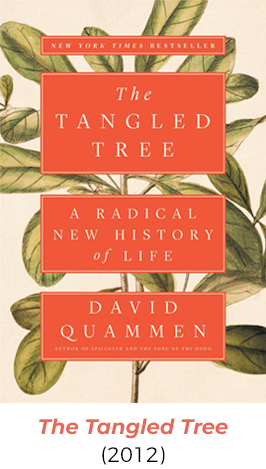
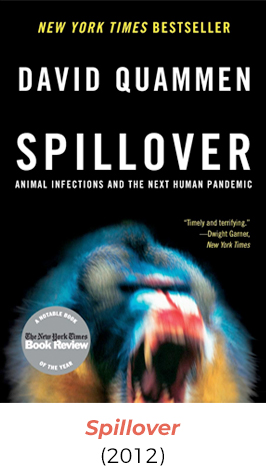
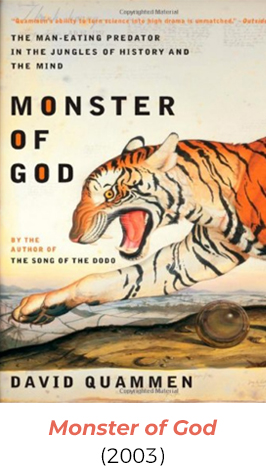
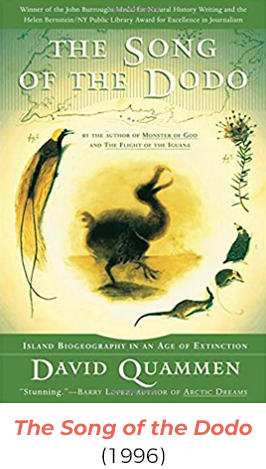
Todd Wilkinson, who lives in Bozeman, is a western correspondent for National Geographic and The Guardian, and is founder of Mountain Journal (mountainjournal.org), a nonprofit, public-interest journalism site devoted to exploring the intersection of people and nature in the Greater Yellowstone Ecosystem. His column, The New West, also appears weekly in the Explore Big Sky newspaper.

